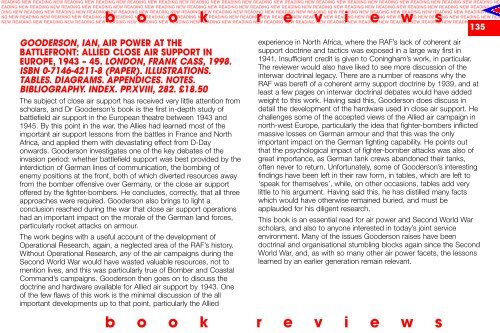THE RAF AIR POWER REVIEW - Royal Air Force Centre for Air ...
THE RAF AIR POWER REVIEW - Royal Air Force Centre for Air ...
THE RAF AIR POWER REVIEW - Royal Air Force Centre for Air ...
Create successful ePaper yourself
Turn your PDF publications into a flip-book with our unique Google optimized e-Paper software.
READING NEW READING NEW READING NEW READING NEW READING NEW READING NEW READING NEW READING NEW READING NEW READING NEW READING NEW READING NEW READING NEW READING NEW READING NEW READING NEW<br />
EADING NEW READING NEW READING NEW READING NEW READING NEW READING NEW READING NEW READING NEW READING NEW READING NEW READING NEW READING NEW READING NEW READING NEW READING NEW READING NEW<br />
DING NEW READING NEW READING NEW READING NEW READING NEW READING NEW READING NEW READING NEW READING NEW READING NEW READING NEW READING NEW READING NEW READING NEW READING NEW READING NEW RE<br />
NG NEW READING NEW READING NEW READING NEW READING NEW READING NEW READING NEW READING NEW READING NEW READING NEW READING NEW READING NEW READING NEW READING NEW READING NEW READING NEW REA<br />
NEW READING NEW READING NEW READING NEW READING NEW READING NEW READING NEW READING NEW READING NEW READING NEW READING NEW READING NEW READING NEW READING NEW READING NEW READING NEW READIN<br />
b o o k r e v i e w s<br />
GOODERSON, IAN, <strong>AIR</strong> <strong>POWER</strong> AT <strong>THE</strong><br />
BATTLEFRONT: ALLIED CLOSE <strong>AIR</strong> SUPPORT IN<br />
EUROPE, 1943 – 45. LONDON, FRANK CASS, 1998.<br />
ISBN 0-7146-4211-8 (PAPER). ILLUSTRATIONS.<br />
TABLES. DIAGRAMS. APPENDICES. NOTES.<br />
BIBLIOGRAPHY. INDEX. PP.XVIII, 282. £18.50<br />
The subject of close air support has received very little attention from<br />
scholars, and Dr Gooderson’s book is the first in-depth study of<br />
battlefield air support in the European theatre between 1943 and<br />
1945. By this point in the war, the Allies had learned most of the<br />
important air support lessons from the battles in France and North<br />
Africa, and applied them with devastating effect from D-Day<br />
onwards. Gooderson investigates one of the key debates of the<br />
invasion period: whether battlefield support was best provided by the<br />
interdiction of German lines of communication, the bombing of<br />
enemy positions at the front, both of which diverted resources away<br />
from the bomber offensive over Germany, or the close air support<br />
offered by the fighter-bombers. He concludes, correctly, that all three<br />
approaches were required. Gooderson also brings to light a<br />
conclusion reached during the war that close air support operations<br />
had an important impact on the morale of the German land <strong>for</strong>ces,<br />
particularly rocket attacks on armour.<br />
The work begins with a useful account of the development of<br />
Operational Research, again, a neglected area of the <strong>RAF</strong>’s history.<br />
Without Operational Research, any of the air campaigns during the<br />
Second World War would have wasted valuable resources, not to<br />
mention lives, and this was particularly true of Bomber and Coastal<br />
Command’s campaigns. Gooderson then goes on to discuss the<br />
doctrine and hardware available <strong>for</strong> Allied air support by 1943. One<br />
of the few flaws of this work is the minimal discussion of the all<br />
important developments up to that point, particularly the Allied<br />
experience in North Africa, where the <strong>RAF</strong>’s lack of coherent air<br />
support doctrine and tactics was exposed in a large way first in<br />
1941. Insufficient credit is given to Coningham’s work, in particular.<br />
The reviewer would also have liked to see more discussion of the<br />
interwar doctrinal legacy. There are a number of reasons why the<br />
<strong>RAF</strong> was bereft of a coherent army support doctrine by 1939, and at<br />
least a few pages on interwar doctrinal debates would have added<br />
weight to this work. Having said this, Gooderson does discuss in<br />
detail the development of the hardware used in close air support. He<br />
challenges some of the accepted views of the Allied air campaign in<br />
north-west Europe, particularly the idea that fighter-bombers inflicted<br />
massive losses on German armour and that this was the only<br />
important impact on the German fighting capability. He points out<br />
that the psychological impact of fighter-bomber attacks was also of<br />
great importance, as German tank crews abandoned their tanks,<br />
often never to return. Un<strong>for</strong>tunately, some of Gooderson’s interesting<br />
findings have been left in their raw <strong>for</strong>m, in tables, which are left to<br />
‘speak <strong>for</strong> themselves’, while, on other occasions, tables add very<br />
little to his argument. Having said this, he has distilled many facts<br />
which would have otherwise remained buried, and must be<br />
applauded <strong>for</strong> his diligent research.<br />
This book is an essential read <strong>for</strong> air power and Second World War<br />
scholars, and also to anyone interested in today’s joint service<br />
environment. Many of the issues Gooderson raises have been<br />
doctrinal and organisational stumbling blocks again since the Second<br />
World War, and, as with so many other air power facets, the lessons<br />
learned by an earlier generation remain relevant.<br />
b o o k r e v i e w s<br />
135

















